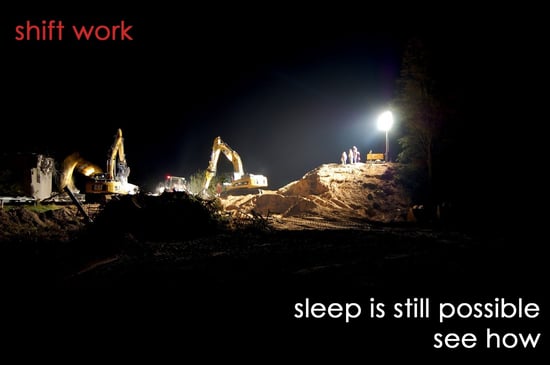Shift Work and Sleep

A shift worker is anyone whose work schedule does not follow the typical 9-5 business day. The most typical example of this are businesses that operate 24 hours per day. This is increasingly common as modern demands and competition push businesses production and customer service. Millions of Americans are working non-traditional hours (about one-fifth of the US population [1]) – are you?
The most common risk of shift work are persistent sleep problems, generally resulting in either excessive sleepiness and/or nighttime sleep interruptions [2]. Only 63% of shift workers report that their work schedule allows them to get enough sleep (compared to 89% for non-shift workers) [3]. If you are a shift worker, are you getting enough sleep?
Risks of Shift Work
The well-documented risks associated with shift work are [National Sleep Foundation]:
- Less sleep than traditional workers
- Issues with morale
- Have increased health risks for [4]:
- Peptic ulcers
- Coronary heart disease
- Insulin resistance
- Metabolic syndrome
- Respiratory infections
- Have higher rates of depression (than traditional workers)
- High rates of morbidity (than traditional workers)
What is Shift Work Sleep Disorder
Sleep disturbances from shift work are so common and closely related that there is a term for it: shift work sleep disorder (SWSD), which is simply chronic circadian rhythm sleep disorder caused by shift work [5].
The consequences of SWSD are workers who are significantly more at risk for:
- Accidents
- Errors
- Injuries
- Fatalities
- Lack of awareness
- Poor concentration
- Poor decision making
This is rather alarming when you consider that many shift workers are employed in dangerous jobs like medical services, law enforcement, transport industry, and firefighting.
Factors Affecting You and SWSD
Just because you work a shift schedule does not automatically mean you are going to have sleep problems. The main factors affecting whether you may struggle from SWSD are:
- Your natural sleep schedule
- Which shift schedule you work
For example, if your natural sleep rhythm involves going to bed at 2am you may easily adjust to a night-shift. If your natural circadian rhythm involves going to bed at 8pm then you may easily adjust to an early morning-shift.
Other factors to consider are:
- The frequency of your shift work
- The regularity of your shift work – are you changing to different shifts regularly?
- Genetic component (certain genes predispose night-shift workers to sleepiness)
Inconsistent, changing shift schedules can be extremely challenging to adjust to.
Diagnosing SWSD
Like all other circadian rhythm sleep disorders, SWSD requires a clinical assessment that includes sleep history.
Some ways that clinical sleep specialists will evaluate you are:
- Analysis of your sleep-wake schedule
- Analysis of pre-existing sleep disorders, such as restless leg syndrome or sleep apnea
- Potentially a polysomnogram (a type of sleep study)
Essentially, a diagnosis simply aims to find the “root cause” of symptoms. In this case, sleep specialists will ensure that your sleep problems stem from shift work and not something else.
How to Treat Shift Work Sleep Disorder
Most treatment regimens are designed to help workers synchronize their circadian rhythm to their shift work:
- Avoid bright light before sleep, such as by getting blackout curtains and avoiding screens before bed
- Soundproofing your bedroom to keep out daytime noise
- Setting pre-sleep routines, such as using the same scent and series of steps before bed
- Educating family members of shift workers are the importance of uninterrupted sleep
Other treatment regimens may involve sedative medications or wake-enhancing medications.
Your treatment regimen should be unique to your needs and is something that should be established with a clinical sleep specialist. Please click the button below to talk to one of our sleep health professionals and work on creating a regimen that works for you.
References
[1] Drake CL, Wright KP, “Shift Work, Shift-Work Disorder, and Jet Lag,” in In Kryger M, Roth T, Dement W (ed.), Principles and Practice of Sleep Medicine (5th Edition), St. Louis: Elsevier Saunders, 2011, pages 784-798.
[2] Akerstedt T. Shift work and disturbed sleep/wakefulness. Occup Med (Lond). 2003; 53:89-94.
[3] National Sleep Foundation (NSF), Shift Work Disorder: What is Shift Work? Arlington, VA: NSF, 2014.
[4] Knutsson A. Health disorders of shift workers. Occup Med (Lond). 2003;53:103-108.
[5] American Academy of Sleep Medicine. The international classification of sleep disorders: diagnostic and coding manual. 2nd ed. Westchester, Ill: American Academy of Sleep Medicine; 2005.


